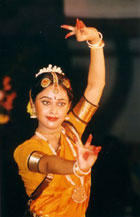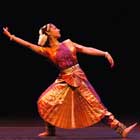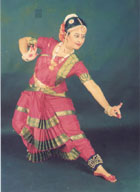The term "Tanjore Quartet", also known as the "Thanjai Naalvar" in Tamil,
refers to four brothers - Chinnayya (1802-1856), Ponnayya (1804-1864),
Sivanandam (1808-1863) and Vadivelu (1810 - 1845). They were nattuvanars
or dance masters of the Isai-Vellalar caste, at the royal court of
Maratha king Serfoji II ((AD.1798-1832))in Tanjavur during the early nineteenth century.
At the encouragement of the king they learnt the nuances of Carnatic music
from a number of exponents of their time. from the court of king Serfoji,
the brothers moved to Travancore and were patronised by the Maharaja Swathi
Tirunal.The Maharaja appointed Vadivelu as the court mucisian. Vadivelu also learnt
to play the violin from a European missionary. He introduced violin in
Carnatic music. Vadivelu also introduced the concept of Mohiniaattam.
Up to that time Kathakali was the prevalent dance form in Kerala. It was
confined to male dancers. Vadivelu elaborated and refined Mohiniattam along
with the Maharaja, and this opened the doors for women dancers of Kerala.
The Tanjore Quartet organised all the basic Bharatnatyam movements of pure
dance into a progressive series called Adavus (steps). They composed new music
specifically for Bharatnatyam and introduced a different sequence of
items that brought out the various aspects of dance and music.
The Tanjore Quartet transformed both the temple ritual of the gracious Devadasis (temple-dancers)
and the court presentation of Sadir (as the dance was known and later renamed by there descendants:
Bharata Natyam). The contemporary theatre profile is not equivalent to the temple ritualistic
performance of Devadasis.
One of the famous exponent of Tanjore Quartet style was Guru Thiru K.P. Kittappa.
Guru Thiru K.P. Kittappa interacted extensively, with students of
Bharata Natyam, within India and abroad. For nearly half a century he trained
students in the Tanjore tradition. Among them: Padmalochini Nagarajan,
Sudharani Ragupathy, Vyjayantimala, Hema Malini, Jayalaksmi, Padmini Rao,
Indhu Varma, Srividya Natarajan, and Hari Krishnan.
Indian music and dance |
   |


